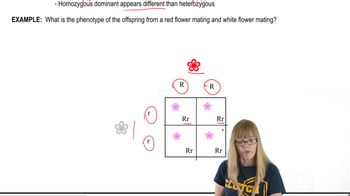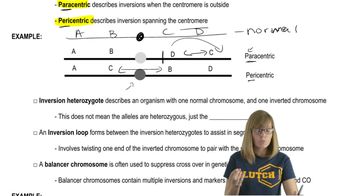Table of contents
- 1. Introduction to Genetics51m
- 2. Mendel's Laws of Inheritance3h 37m
- 3. Extensions to Mendelian Inheritance2h 41m
- 4. Genetic Mapping and Linkage2h 28m
- 5. Genetics of Bacteria and Viruses1h 21m
- 6. Chromosomal Variation1h 48m
- 7. DNA and Chromosome Structure56m
- 8. DNA Replication1h 10m
- 9. Mitosis and Meiosis1h 34m
- 10. Transcription1h 0m
- 11. Translation58m
- 12. Gene Regulation in Prokaryotes1h 19m
- 13. Gene Regulation in Eukaryotes44m
- 14. Genetic Control of Development44m
- 15. Genomes and Genomics1h 50m
- 16. Transposable Elements47m
- 17. Mutation, Repair, and Recombination1h 6m
- 18. Molecular Genetic Tools19m
- 19. Cancer Genetics29m
- 20. Quantitative Genetics1h 26m
- 21. Population Genetics50m
- 22. Evolutionary Genetics29m
2. Mendel's Laws of Inheritance
Probability and Genetics
Problem 31a
Textbook Question
A woman expressing a dominant phenotype is heterozygous (Dd) for the gene.
Draw a pedigree that illustrates the transmission of the dominant trait from the grandmother to two of her grandchildren who are first cousins.
 Verified step by step guidance
Verified step by step guidance1
Start by drawing the grandmother at the top of the pedigree chart. Label her as heterozygous (Dd) for the dominant trait.
Draw two lines down from the grandmother to represent her children. Assume she has two children, a son and a daughter. Label each child with their genotype. Since the grandmother is heterozygous (Dd), each child has a 50% chance of inheriting the dominant allele (D) and a 50% chance of inheriting the recessive allele (d).
For the son, draw a line connecting him to his partner (who is not specified in the problem, so assume she is homozygous recessive, dd). Draw lines down to represent their children. Since the son could be either Dd or dd, determine the possible genotypes of his children.
For the daughter, draw a line connecting her to her partner (also assume he is homozygous recessive, dd). Draw lines down to represent their children. Since the daughter could be either Dd or dd, determine the possible genotypes of her children.
Identify the grandchildren who express the dominant phenotype. These grandchildren must have at least one dominant allele (D). Highlight these individuals on the pedigree chart as they are the ones who inherited the dominant trait from the grandmother.
 Verified video answer for a similar problem:
Verified video answer for a similar problem:This video solution was recommended by our tutors as helpful for the problem above
Video duration:
57sPlay a video:
Was this helpful?
Key Concepts
Here are the essential concepts you must grasp in order to answer the question correctly.
Dominant and Recessive Alleles
In genetics, alleles are different forms of a gene. A dominant allele, represented by a capital letter (e.g., D), masks the effect of a recessive allele (e.g., d) when both are present in a heterozygous individual. This means that individuals with at least one dominant allele will express the dominant phenotype, while those with two recessive alleles will express the recessive phenotype.
Recommended video:
Guided course

Variations on Dominance
Heterozygosity
Heterozygosity refers to the presence of two different alleles at a specific gene locus, such as Dd. In the context of the question, the woman with the genotype Dd expresses the dominant phenotype due to the presence of the dominant allele. Understanding heterozygosity is crucial for predicting the inheritance patterns of traits in offspring.
Recommended video:
Guided course

Inversions
Pedigree Analysis
A pedigree is a diagram that depicts the genetic relationships and inheritance patterns within a family. It uses standardized symbols to represent individuals and their phenotypes, allowing for the visualization of how traits are passed down through generations. In this case, drawing a pedigree will help illustrate how the dominant trait is transmitted from the grandmother to her grandchildren.
Recommended video:
Guided course

Pedigree Flowchart
Related Videos
Related Practice




